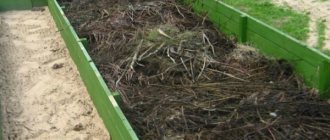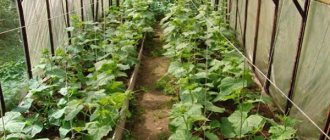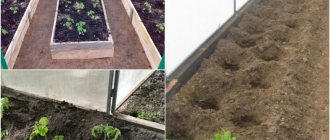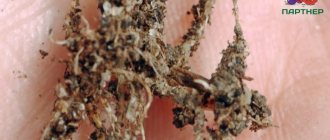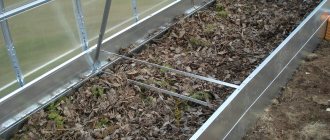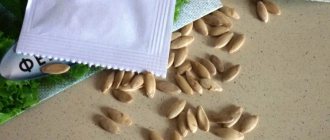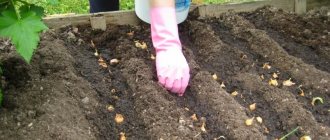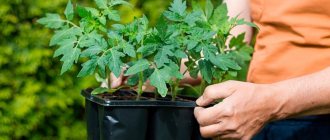What kind of soil do cucumbers like?
The main requirements of the crop for the mechanical composition of the soil are high air permeability and moisture holding capacity, so it is recommended to plant cucumbers on light and medium loams, which have good aeration of the root system, evenly distribute and retain moisture.
For good development, cucumber needs mineral and organic nutrition, which comes from the soil immediately after planting, so the soil must have a high humus content and an optimal ratio of macroelements.
Important minerals:
- Nitrogen. With its deficiency, the growth of the above-ground part and the development of roots slows down.
- Potassium. Mineral deficiency weakens plants and reduces resistance to disease and cold.
- Phosphorus. If there is a shortage, plant growth and fruit formation slow down.
- Magnesium. The leaves turn yellow, become brittle, and fall off. Plant growth and fruit development slows down.
The culture is demanding on the reaction of the soil solution and does not tolerate acidification. The optimal acidity level is pH 6.2-6.8.
Cucumbers love warm soil. Planting seedlings and sowing seeds is possible only after the soil has been warmed to 18°C. When the temperature drops to 14-15°C for 3-5 days, the cucumber roots stop developing.
This can lead to plant death. Surviving cucumbers will be weak and susceptible to disease. Productivity will be greatly reduced.
Cucumbers develop better if the soil is 2-3°C warmer than the air. The average daily air temperature for cucumber is 16-32°C. These indicators are also used to control the soil.
Soil moisture should be 75-85%. Subsequently, to control soil moisture, take a handful of soil from the root layer and squeeze it tightly in your fist. If water comes out, the humidity level is more than 80%. If the lump retains fingerprints, it means the humidity is more than 70%. The lump crumbles - less than 60%.
Soil preparation and arrangement of beds for greenhouses and open ground are the same. The only difference is in the preparatory work.
Greenhouse treatment
Most gardeners do not have the opportunity to observe crop rotation in the greenhouse, so after harvesting, the depleted soil with manure that has rotted over the summer is completely removed from the room and distributed on the site of future beds. The exception is places where pumpkin crops are planted.
If for some reason a complete replacement of the soil is not possible, it must be disinfected.
Options:
- Spill the soil with boiling water and cover the surface of the bed with film for a day. After this, the ground is dug up and harrowed. The procedure is repeated after 3 days. Conducted in the spring.
- Application of biofungicides. Spraying solutions of drugs onto the soil: Trichodermin, Fitosporin M, Phytocide, Bordeaux mixture, Pentafog. Processed in autumn and spring.
- Adding bleach 200 g per 1 sq. m. and digging up the soil. Apply 6 months before planting cucumbers.
- Spill the soil with a 2% formaldehyde solution (40%), cover the surface with film for 3 days. The soil is dug up and harrowed. The event is held 2-4 weeks before planting.
In the fall, all plant residues are collected and burned. The internal surfaces of the greenhouse are washed with a 2% formaldehyde solution (40%). It is advisable to fumigate the greenhouse with sulfur.
Open ground
In open ground, you need to constantly change the place for growing cucumbers, returning the crop back only after 3-4 years. The best predecessors are tomatoes, cabbage, peas. Do not plant after pumpkin crops.
A place for the garden bed is selected that is well-lit, protected from drafts and cold northern winds. In the fall, the site is dug up, removing all plant waste.
In a greenhouse and in open ground, when there is no replacement soil, you can sow green manure plants. The best option is white mustard. It should be sown immediately after harvesting the cucumber plants. After 3-4 weeks, a sufficient vegetative mass is formed, which is embedded in the soil to the depth of a spade bayonet.
Mustard will destroy and remove from the soil most of the cucumber root secretions that have accumulated over the season.
In addition, it produces a kind of compost in the soil, rich in proteins and minerals. A system of root tubules is created in the soil, which improves its mechanical properties.
Dead mustard roots attract worms and microbes, which produce nitrogen during their life processes. Additionally, the soil is protected from erosion and swelling.
In the video, the author shows his method of preparing soil and beds for sowing cucumbers.
Arranging a garden bed
Cucumber is one of the few plants that can and is even recommended to be grown in fresh manure. When laying manure, you need to take into account that the root layer of plants reaches a depth of 20 cm. Therefore, on the surface of the manure there should be a 25-30 cm layer of fertile soil.
In such a bed, a heat-loving crop is not afraid of cooling of the roots when the air temperature drops sharply at night or insufficient heating of the soil when planting early in greenhouses.
To arrange a garden bed in a selected area, mark its boundaries. The width should be such that the gardener can freely reach the plants with both hands. You cannot even lean on boards laid on top of the beds. Cucumber does not tolerate the slightest compaction of the soil.
A trench 50-60 cm deep is dug across the area of the bed. In the spring, two weeks before planting, it is filled with fresh manure. Cover the top with garden soil and fertilize.
If it is very cold, the bed is covered with film for intensive heating. This measure is mainly needed only in unheated greenhouses and regions with late summer.
Fertilizers for cucumbers begin to be applied two weeks before transplanting seedlings or sowing seeds.
For 1 sq. m of cucumber ridge are added:
- rotted manure 25 kg or compost 10 kg;
- superphosphate 40 g;
- potassium sulfate 40 g;
- magnesium sulfate 15 g or potassium magnesium 60 g.
Fertilizers are evenly scattered on the soil surface and the bed is dug up. After this, pour water at a rate of 10 liters per 1 square meter. m.
A week later, 30 g of ammonium nitrate is added per 1 square meter. m. The bed is dug up again and spilled with water. After this, we can assume that the soil is completely ready for planting cucumbers.
The stages of soil preparation should not be neglected. This is one of the most basic agricultural techniques that helps eliminate parasites and fungal spores. The fact is that most harmful microorganisms settle and even survive frosts in the upper layer of soil. When loosening or digging up the soil, the usual habitat of the parasites is destroyed and they die.
Did you know? If you wipe your bathroom mirror with the pulp of a fresh cucumber, it will not fog up.
In addition to the disinfection nature, soil preparation work has the goal of enriching it with nutrients. Over the course of a season, the soil is depleted, so the plants will simply have nothing to eat during the period of active development. As a result, the harvest will be meager and will greatly lose in quality.
At the time of soil preparation, the acidity level is determined. This point is also very important, since cucumbers will not bear fruit in an acidic environment. The optimal value should be from 5 to 7 pH. If the acidity level does not correspond to the specified value, then it is corrected by introducing deoxidizing agents or elements that, on the contrary, increase acidity. Determining soil acidity using litmus paper
Soil structure is another important indicator that affects the growth and development of cucumber crops. Plants do not bear fruit well in heavy clay soils. If the site has just such soil, then it is necessary to carry out work in advance to improve its structural composition by adding sand, peat and other substances that impart looseness.
When cultivating cucumbers in greenhouses, you need to carefully approach not only the preparation of the soil, but also the structure itself. Regardless of whether the portable greenhouse is located on the site or stationary, the walls of the room must be disinfected. Profiles and polycarbonate/film are subject to processing. The outside of the structure is washed with chlorine-containing substances. You can use regular white. It is diluted with water in a ratio of 1:10.
Before you start processing indoors, you need to clean it, take out all garden tools, boxes, etc. The simplest option is to use “Peshka-S” smoke bombs.
The checkers are placed at equal distances from each other along the entire perimeter of the greenhouse, and then the wick is set on fire, starting with the one farthest from the door. The room is then sealed. If it is equipped with ventilation, it must be turned off. The room is left sealed for 8–10 hours.
After treatment, ventilate the greenhouse for 2 weeks.
It is also possible to treat internal surfaces from a tank with a spray gun. For liquid treatments, you can use a 3% solution of copper sulfate or “Fitosporin” (diluted in a ratio of 5:10). You can also use “Fundazol” (30 g per 10 liters of water).
Important! When carrying out disinfection treatments inside the greenhouse, be sure to use protective equipment for the eyes and respiratory tract. Clothing should be chosen that fits tightly to the body, with long sleeves and a high collar.
In autumn
The main problem of a greenhouse is the relatively small area of food for plants. In this regard, it is not always possible to comply with the rules of crop rotation. In the case of a mobile structure, you can simply move it to another place, having previously prepared the site in the usual way. In the case of a stationary greenhouse, a partial or complete change of soil is carried out.
If the soil is partially changed, immediately after harvesting, the premises are disinfected. The soil is dug up onto the bayonet of a shovel, and then sprinkled with a layer of bleach. The remaining work is carried out in the spring.
In rack greenhouses, a complete change of spent soil is carried out in the fall. First, a 10 cm layer of cow dung is placed in empty boxes, then a layer of soil of the same thickness is placed. After 3–5 days, add a layer of soil (15 cm).
in spring
In spring, a layer of soil of 10–20 cm is removed. The site is dug up to a depth of 25 cm.
To increase the fruitfulness of plants, the following manipulations are carried out in greenhouses in the spring:
- In place of the removed layer of soil, 30–40 cm of manure is laid.
- Form depressions in it at equal distances.
- 1 liter of boiling water is poured into the recesses - this is necessary to activate the rotting process, which will contribute to the release of heat.
- After 5 days, a mixture of turf soil, sawdust, sand and humus (2:1:1:2) is placed on top of the manure.
Gardening tips
Experienced gardeners have their own secrets for growing rich harvests of cucumbers in a greenhouse. Most of them relate to recommendations for selecting the right variety and quality seeds, but there are also those that relate to soil preparation:
- promptly remove weeds and plant debris from the previous season;
- fertilize according to soil type;
- do not forget to change the place where crops are grown;
- monitor the level of calcium in the soil: its lack can lead to rot;
- carefully check the soil in the greenhouse for the presence of stones and loosen it thoroughly, otherwise the bushes will have weak roots.
Prepared soil for cucumbers in a greenhouse. Greenhouses must be prepared for planting cucumbers starting in November. Then, by the time the seeds are planted, the necessary microclimate is formed in the soil. However, for a high-quality harvest, autumn preparation is only the first stage. Next, it is necessary to ensure regular watering and timely fertilizing of the plantings, as well as to prevent the appearance of possible pests and diseases.
How to prepare soil for planting cucumbers
Unprepared soil in a greenhouse will not cause significant harm to cucumber plantings, however, you should not expect a large harvest. Infections or pests left over from last season can affect the fruits on the bushes. Moreover, if the composition of the soil or its acidity turns out to be unsuitable for growing cucumbers, then the seeds may not even hatch.
Preparation in the fall consists of a set of measures aimed at changing its composition and structure according to the requirements of each plant. First, let's figure out what exactly is good for cucumbers. Having all the agronomic knowledge, you will be able to create all the necessary conditions for growing this vegetable.
Read about the best varieties of tall tomatoes for greenhouses at the link.
Soil requirements
The root system of cucumbers is very weak - one main root, tender and fragile. Therefore, fruits in winter require loose loamy soil, in which it will be easy for it to gain a foothold. An equally important indicator is acidity. The soil should be neutral or, at least, slightly acidic with a pH value of no more than 7 units.
Read about preparing a greenhouse for tomatoes in the fall here.
Predecessors
In some cases, other vegetable crops can partially prepare the soil for you. If you alternate different vegetables correctly and do not plant the same plants for more than 2-3 years in a row. Compliance with crop rotation ensures the preservation of soil structure and also prevents the transmission of diseases such as late blight.
Cucumbers cannot be planted after similar plants, such as zucchini, melons (watermelons, melons), and pumpkins. Planting after nightshades is also unfavorable, especially after tomatoes have been planted in a polycarbonate greenhouse. They will grow well after early ripening white cabbage, root vegetables or peppers.
Soil preparation before planting crop rotation
Fertilization of fruits usually occurs in September. It can be done in the spring, but then the humus will not provide heating to the soil and planting will be delayed indefinitely. We begin this task after the harvest has been harvested and the greenhouse has been cleaned and disinfected. Check the condition of the structures; it is much easier to correct all problems before sowing.
The procedure for laying fertilizers:
- remove last year's soil to a hard sandy-loamy layer;
- Place some branches at the bottom of the beds (you can use pruned shoots of bushes and fruit trees);
- sprinkle such a “frame” of the bed with black soil;
- pour out manure at the rate of 1 bucket per square meter;
- lay down as much compost and humus as can be mixed with last year’s soil (shake it well to remove weed roots);
- the top layer should consist of 1:1 humus and ordinary loose sandy soil.
This layer cake will be an excellent help for growing cucumbers. During the winter, try to ensure that the prepared soil does not freeze. To do this, cover it with snow; this method will also help moisten the beds in the spring.
Liming
As already mentioned, cucumbers need neutral or slightly acidic soil. It is necessary to lime the soil at elevated pH levels. If the pH is too high, then you will have to work with the chemical composition of your beds. Liming the soil will help you. The simplest and most affordable way is to scatter 200 g of quicklime per meter.
In boxes and barrels
The limited space of boxes, barrels or other containers requires a slightly different approach to the composition and preparation of the soil.
When using drums and other tall containers:
- on the bottom lay a layer of pebbles, broken bricks, strong branches for 1/3 of the container;
- put hay, sawdust and tops on top, sprinkle with humus or rotted manure - after laying this layer, 40 cm remains to the edge of the container;
- poured with EM preparations for better reheating;
- mix leaf soil and humus (1:1) or peat and humus (1:1);
- cover with a 20 cm layer.
The container is covered with film and left to overheat for two weeks. Add fertile soil so that 15 cm remains to the edges of the sides of the container. Two weeks before planting, the soil is fertilized for cucumbers.
On balconies and window sills, cucumbers are grown in containers with a volume of at least 5-7 liters (depending on the variety). At the bottom of the pots there must be holes for water drainage and a drainage layer 5 cm high. A layer of fertile soil must be at least 20 cm.
Ready-made and homemade soils recommended for seedlings are well suited for growing cucumbers in containers. They contain a large amount of nutrients, which is especially important when the root environment is limited.
Cultivated plants, including cucumbers, remove almost all nutrients from the soil during the season. She's getting exhausted. Salinity, increased acidity and severe drought sharply reduce the level of soil bacteria, and hence the formation of humus, so the soil must be constantly monitored, not limited to seasonal fertilization.
in spring
You can get by with the standard option of replacing the soil layer with a fertile substrate consisting of turf soil, peat, sand and humus with field soil (2: 1: 1: 1). A number of mineral components are immediately added to this composition:
- 15 g potassium sulfate;
- 20 g superphosphate;
- 10 g ammonium nitrate.
Did you know? In ancient Rome, cucumbers were used as a remedy for scorpion stings. The victim was required to introduce them into the diet and apply the rings of the fruit to the affected area.
The soil on the site begins to be prepared in the fall, and this work continues in the spring. To begin with, select an area that is well lit by the sun, without drafts. When choosing an area for cucumbers, take into account the rules of crop rotation. The crop is not planted after:
- zucchini;
- squash;
- eggplant;
- tomatoes;
- potatoes.
in autumn
At this stage, the area is first cleared of plant debris, and the roots must be removed. All vegetation collected from the site is burned. Then the ashes from the fire can be used as a disinfectant and fertilizer.
Next, deep cultivation is carried out. This can be done using an ordinary shovel, digging onto a bayonet. This method of cultivation is suitable if there is loose, light soil on the site. Heavy soils need to be dug to a greater depth (40 cm). For this you will need a cultivator.
Immediately after the first digging, the soil is disinfected. A week later, for repeated digging to a depth of 30 cm, 6-10 kg of fresh manure is added to each 1 m² (for light ones, less fertilizer, for heavy ones - more). If the soil is highly acidic, instead of manure, for every 1 m², add 600 g of wood ash or 400 g of dolomite flour and 10 kg of compost.
On heavy soils, structuring is carried out, which involves adding for every 1 m²:
- 20 kg of manure;
- 10 kg of peat;
- 10 kg of sand.
You can increase the efficiency of all the above-described manipulations by mulching the fertile layer. To do this, combine sawdust, straw, sunflower husks, and grass in equal proportions. Lay the mulch in layers 3–5 cm high, mixing them with soil. A total of 2-3 layers are done. By spring, some of the organic matter will already have time to decompose in the soil, which will increase its fertility.
in spring
In early spring, another cultivation is carried out to a depth of 20–25 cm.
At the end of May, around the 20th, you need to replenish the soil with minerals. For every 1 m² contribute:
- 15 g ammonium nitrate;
- 20 g superphosphate;
- 15 g of potassium salt (if deoxidizers in the form of dolomite flour or wood ash were not used in the fall).
Important! Before planting cucumber seedlings, carefully ensure that weeds do not appear. As soon as such vegetation begins to emerge, remove it immediately, otherwise the effectiveness of all preparation procedures will decrease and the risk of pest proliferation will increase.
Fertilizers should be applied to moist soil. If the spring turns out to be dry, the area must first be watered (20 liters of water per 1 m²). Fertilizers are applied to a depth of 10 cm. After this, the soil is leveled using a rake.
Feeding cucumbers
Before sowing this crop in a greenhouse, special attention should be paid to fertilizing. A common option here is to use ash
With its help, you can significantly increase crop productivity. But, in addition to this, cucumbers need feeding using other fertilizers that have a certain effect. If the bed is prepared and fertilized correctly, the harvest will be very good.
In the first weeks after planting in prepared soil, cucumbers do not need fertilizer. Here it will be enough to use nitrogen feed. Phosphorus supplementation is applied before inflorescences appear. During the period of flowering and fruit formation, plants begin to consume large amounts of nutrients. Therefore, the culture must be processed very carefully. Fertilizers are applied a month after planting the seedlings. This will create a supply of nutrients that are necessary for the normal development of plants.
To begin with, experts recommend using nitrogen-potassium fertilizers. This is quite enough at the initial stage of growing the crop. It is better to fertilize vegetable gardens in the evening. After adding the substance, the plant is watered with warm water. Additionally, fertile soil is added under the root. It is worth noting here that greenhouse seedlings absorb liquid fertilizers better.
You can increase the yield of cucumbers in a polycarbonate greenhouse by increasing the level of carbon dioxide in the air. To do this, you simply need to place a barrel half filled with manure in a closed space. Add water to the top. The contents of the barrel are stirred daily. After a few days, fermentation begins, which is accompanied by the release of carbon dioxide. The contents are subsequently used as fertilizer.
Preparing the soil for cucumbers in a greenhouse in the spring must be done very carefully. Here we are talking not only about updating or enriching the soil, but also about preparing the structure itself. Therefore, you need to approach this work very carefully.
Definition and structuring of different soil types
Before you begin the basic preparation of the soil for cucumbers, you need to put its mechanical composition and physical properties in order. Create an optimal base into which fertilizers will subsequently be applied according to the requirements of the cucumbers. The task is especially relevant when developing a new site.
To determine the type of soil, you can use a simple method that does not require special equipment. To do this, you need to take a handful of earth and lightly moisten it with water so that it does not wring out. Mash and form a lump. Then roll a cord with a diameter of 3 mm in your palms and roll it into a solid ring.
Depending on the condition of the cord, you can determine the type of soil:
- disintegrates quickly - sandy loam;
- crushes during rolling - light loam;
- continuous, but when rolled into a ring it breaks up - medium loam;
- continuous, but small cracks form on the ring - heavy loam;
- solid, solid ring - alumina.
The most optimal soil types for growing cucumbers. The mechanical composition of light loams does not need to be structured. In the fall, manure is added to medium loams at a rate of 5-6 kg per 1 sq. m. m.
Sandy loam
This type of soil warms up quickly, has intense aeration and high water permeability. In addition, sandy loam is easy to process, and the conversion of organic matter into humus occurs at an accelerated rate.
The disadvantages of soil for growing cucumbers are rapid cooling at night and leaching of minerals from the root layer. This can be corrected by adding fresh manure or compost in the fall, 10 kg per 1 sq. m. m.
These types of soil are not suitable for growing cucumbers. They do not warm up well and practically do not allow air and moisture to pass through. This is detrimental to culture.
When oxygen access to the roots is limited, cucumbers begin to shed their ovaries, practically do not develop and gradually dry out. Heavy soils must be loosened.
The best option is to apply fresh straw manure. This should be done in the fall so that it has time to decompose and turn into humus. 10-15 kg of manure per square meter is applied to uncultivated soils. m. When re-applying (recommended every 3-4 years), 5-6 kg per square meter is sufficient. m.
Manure is covered superficially. When buried deeply, it does not decompose and partially turns into peat, in which the bacteria necessary for plants do not develop.
Sandstones
This type of soil is not suitable for growing cucumbers. It does not retain moisture, and minerals are quickly washed out of the root layer. It warms up quickly, but also cools down during the night temperature drop.
To improve the soil per 1 sq. m. contribute:
- half-rotted manure or compost 1.5 -2 buckets;
- peat 1 bucket.
A labor-intensive, costly, but very effective method is claying the soil. To do this, in every sq. m. add 1-2 buckets of powdered clay. It is combined with manure or compost. After adding any baking powder, the area is dug up. The events are carried out over 2-3 years.
Peaty marshy
In Russia, this type of soil is found in the West Siberian Plain and in its natural form is unsuitable for growing cucumbers. It is excessively moist and fibrous, there are no conditions for the decomposition of plant residues, so the peat becomes very sour. Peaty-swampy soil is characterized by a light brown color.
First you need to dry the area. To do this, in the spring, grooves are dug along the perimeter of the site so that the water is drained outside the garden. By the end of summer, the area will be dry, and you can begin to improve the soil.
For 1 sq. m. contribute:
- powder clay 1 bucket;
- river sand 0.5 buckets;
- lime from 0.3 to 1.4 kg depending on acidity.
The area is dug up to a depth of 20 cm. Rotted manure, humus or bird droppings are added at a rate of 1 kg per square meter. m. More organic matter is not required.
Peat contains a lot of organic substances, and manure in this case is used only to start the processes of its decomposition.
Work on introducing these components is carried out constantly from year to year. Until the soil acquires optimal physical properties that are comfortable for plants. In addition to the main fertilizers (nitrogen, phosphorus, potassium), copper and boron are added annually.
Seed preparation
To obtain strong seedlings or viable seedlings, it is necessary to properly carry out the pre-sowing preparation of cucumber seeds. The standard pre-planting preparation technology consists of the following activities:
- The easiest way to increase the germination rate of cucumbers is to soak the seed material in water at room temperature.
- In order to discard seeds that are unsuitable for planting, you should soak them in a solution of ordinary table salt, prepared at the rate of 50 g of the substance per liter of water.
- Before planting, it is recommended to warm the seed material at a temperature of 60°C for two hours.
- To disinfect seeds using the dry dressing method, the drug “NIUIF-2” or “Granozan” is used at the rate of 3 g of the product per kilogram of seed material. The drug “TMTD” has a good disinfecting effect, which should be used at the rate of 4 g per kilogram of seeds.
- The wet disinfection method involves the use of a 1% solution of potassium permanganate, in which the seeds are immersed for ½ hour, after which they should be washed with running water.
Most gardeners have been using the method of germinating cucumber seeds on damp cloth for many years. You can also reduce the risk of seedling material becoming infected with diseases by treating the seeds with Prestige or Fitosporin.
Formation of beds
The beds in a greenhouse for cucumbers are formed based on the size of the greenhouse, usually marked out in groups of 2-3. You should not make them wider than 1 meter, so as not to impede access to the plants and make caring for them easier. Special borders installed along the edge of the bed will help prevent the soil layer from being washed away when watering.
The most favorable location of beds for greenhouse plants is from west to east. In this case, the cucumbers receive maximum light throughout the day.
It is important to remember that the optimal distance between sprouts in a row should be 30 cm, between rows 25-30 cm. It is necessary to retreat at least 23-27 cm from the walls.
Based on this, the locations of future plantings are marked. Many gardeners who have greenhouses at their disposal prefer to sow seeds immediately in order to bypass the stage of “home” seedlings.
The second option is to plant ready-made seedlings. Cucumbers are planted in a greenhouse on April 14-22 at the age of 26-30 days, maintaining distances between sprouts. During the period of seedling establishment (1 week), it is advisable to increase the temperature in the greenhouse to 27°C and the humidity to 86-87%.
Cucumbers are a semi-melon crop, so both in the greenhouse and in the open ground they need raised, high beds. It is better to form them in the fall, so that the constructed embankments can form their own microclimate and their own chemo-bio-environment. Remember that the top layer of soil should be well mixed and loose. Try to lay the beds so that organic additives (especially manure) do not lie in the open air; cover them thoroughly with soil. Under the ceiling of the greenhouse, pre-stretch the wire to which you will tie the cucumber vines.
Necessary equipment
To grow cucumbers indoors, two conditions are important: a suitable greenhouse and its equipment. When choosing a shelter, please note that polycarbonate greenhouses have more advantages than those based on film or frame. They are easy to transport, rearrange and assemble, wear-resistant, have minimal influence of weather conditions, and are more airtight.
The size of the shelter must be at least 10 square meters. m, and the height is about 2 m. It is not recommended to build a higher greenhouse, since maintaining the microclimate in it will be problematic due to the large layer of air. But a lower height when growing cucumbers is also unacceptable. This is due to the fact that cucumber vines, if placed vertically, will not have enough space; their length can exceed 3.5 m.
The choice of location for installing the greenhouse is of great importance. It should be a flat surface or a small hill so that groundwater does not flood it and cause mold to appear.
The greenhouse should be installed in a north-south direction to optimize the receipt of natural sunlight and heat.
Acidity regulation
Acidic soil is typical for low-lying areas with stagnant spring water. Acidity can also increase after seasons with increased rainfall, which wash away calcium and magnesium. Hydrogen ions begin to predominate in soil particles, increasing its acidity.
In such areas, plantain, wild rosemary, horsetail, speedwell and sorrel grow rapidly. When digging up the soil at a depth of 10-15 cm, you can find a light-colored layer resembling ash.
The easiest and most inexpensive way to determine soil acidity is to use litmus paper. It can be purchased at any garden store and pharmacies.
To determine the acidity of the soil, mix a semi-liquid solution of soil and distilled water, and immerse a strip of litmus paper in it for 2-3 seconds. To calculate acidity values, it is compared with the accompanying color scale.
Calcium carbonate is used to reduce soil acidity. It is found in ground limestone, chalk, cement dust, wood ash, dolomite and bone meal.
For the primary regulation of acidity, it is better to use ground limestone. Norms for its application per 1 sq. m. for various soil types (pH {amp}lt; 4.5/ pH 4.6-6.0):
- sand 400/100 g;
- sandy loam 600/150 g;
- loamy 800/350 g;
- aluminas 1100/500 g;
- peat-swampy 1400/300 g.
Cucumbers are very sensitive to liming, so measures to reduce soil acidity are best carried out under the previous crop. As a last resort - in the fall.
In the future, to maintain acidity at the required level, wood ash is used, which also serves as a good fertilizer.
General recommendations for preparing soil for cucumbers and caring for them
General soil requirements for growing cucumbers:
- the soil should be loose, saturated with oxygen;
- contain a large amount of organic and mineral matter;
- have an acidity level of 6.2-6.5;
- the soil should not contain infections and harmful microorganisms.
Proper soil care is as follows:
- To prevent the soil from drying out, regular watering is required;
- the application of mineral fertilizers helps enrich the soil with nutrients;
- creating a favorable microclimate inside the greenhouse to avoid excessive soil moisture;
- Regular ventilation of the greenhouse to prevent fungal diseases.
Growing seedlings
The seedling method of growing many garden crops has significant advantages, including earlier harvesting and prolongation of the fruiting period of plants. High-quality cucumber seedlings can be grown on a window, following the appropriate technology. The key to obtaining strong and high-quality seedlings is strict adherence to temperature and light conditions . In addition, it is necessary to maintain an optimal humidity level within 50-60%.
After sowing cucumber seeds and before the appearance of mass shoots, the temperature in the room should be at least 22-24°C. After emergence of seedlings, the temperature must be lowered to 16-18°C, which will not allow the seedlings to stretch out excessively. It is important to accompany the decrease in temperature with additional lighting. If necessary, cucumber seedlings are picked into separate seedling containers.
Properly grown cucumber seedlings have fairly strong stems no more than 25-28 cm high, with short internodes, dense and dark green leaves, and also have a well-developed root system.
